The Face of Sustainability
Rain drops burst through the atmosphere, pelting roofs, windows and the windshields of passing vehicles. Trees, flowers and other vegetation glisten from the newly fallen precipitation, soaking up only what is needed. As the excess flows, contaminants are washed away, carrying along trash and other debris, before eventually overflowing into tributaries, streams, rivers and lakes.
While the quality of the runoff entering the waterways can never be completely controlled, Tarrant County College diligently works to reduce the negative impact of the water running off its properties. The effort is part of TCC’s commitment to environmental sustainability.
For an organization with as vast an environmental footprint as TCC’s, taking care of what many may consider to be trivial details translates into a significant and positive impact for the community.
“Commitment to the small details of the everyday College tasks of washing vehicles and blowing cut grass are making major differences in how TCC reduces the amount of pollution that flows into the water ways from its six campuses,” said Steven Kleypas, TCC’s director of environmental management.
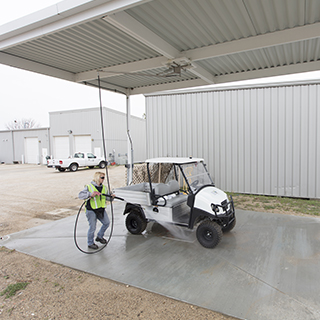 Part of TCC’s commitment to sustainability is evident in the infrastructural improvements
the College has made to minimize and/or eliminate any harm to the environment. “We
have constructed wash bays on all campuses. Vehicle washing is no longer allowed in
the maintenance areas except in the wash bays. Dirt, oil and soap from washing vehicles
and equipment is captured and not allowed to wash into the storm drains,” said Kleypas,
explaining the importance of adhering to best practices. “We train staff to blow grass
and leaves back onto the grounds after mowing rather than out into the street. When
grass, carrying fertilizers and other chemicals, washes into a waterway, it creates
problems with oxygen demand, ultimately stressing fish and other marine life.”
Part of TCC’s commitment to sustainability is evident in the infrastructural improvements
the College has made to minimize and/or eliminate any harm to the environment. “We
have constructed wash bays on all campuses. Vehicle washing is no longer allowed in
the maintenance areas except in the wash bays. Dirt, oil and soap from washing vehicles
and equipment is captured and not allowed to wash into the storm drains,” said Kleypas,
explaining the importance of adhering to best practices. “We train staff to blow grass
and leaves back onto the grounds after mowing rather than out into the street. When
grass, carrying fertilizers and other chemicals, washes into a waterway, it creates
problems with oxygen demand, ultimately stressing fish and other marine life.”
TCC’s salient efforts to protect another critical water source impacting the state’s waterways recently earned the College recognition. During the first year it was eligible, TCC earned the City of Fort Worth Star Award for 100 percent compliance with city, state and federal pretreatment requirements at the Erma C. Johnson Hadley Northwest Center of Excellence for Aviation, Transportation and Logistics, the one TCC facility subject to special procedures because of potential contaminants used in the aviation industry.
“Our goal is to minimize, or better yet, not contaminate discharged water with industrial wastes from our facilities into the public sanitary sewer system. These pollutants make the cleanup process much more difficult and expensive,” said Kleypas, adding that treated water quality is crucial because once it makes its way to rivers and lakes, it eventually could become drinking water.
Not only does TCC work hard to protect the quality of the water, but strategically protects its bottom line for taxpayers by wisely monitoring the use of this critical resource. Determining the amount of water to replenish vegetation is not left to chance. TCC uses software to apply the principles of evapotranspiration, the science of how plants use water, to know what sprinkler adjustments need to be made and when, allowing the College to save millions of gallons of water and thousands of dollars each year.
“Because of the scientifically computerized systems it uses, TCC’s facilities teams can determine proper amount of water to use based on specific conditions,” said David Hoelke, TCC’s director of system infrastructure, Energy Management. “That may seem like a small thing, but when 65 percent of an institution’s water is used for irrigation, then the savings are astronomical,” he said.
Hoelke said the use of such best practices enabled the College to earn city recognition six consecutive years. In recognition of the first five consecutive years, TCC earned the Blue Water Drop Trophy in 2016 as part of the SmartWater Conservation Partner program.
During that period, TCC reduced its maximum use of water in excess of nearly 151.5 gallons by 23 percent to 116.3 million gallons per year by saving more than 35 million gallons, the equivalent of how much water can serve 328 households using an average of 107,000 gallons of water per year.
Footprint Reduction
TCC distinguished itself for making an ongoing environmental impact when two new buildings were built on campuses in Arlington and south Fort Worth. By meeting rigid building requirements, both buildings qualified to receive national distinction by the U.S. Green Building Council (USGBC). USGBC is dedicated to transforming “the way buildings and communities are designed, built and operated, enabling an environmentally and socially responsible, healthy and prosperous environment that improves the quality of life.”
When it was time to expand Southeast Campus to accommodate a student population that was three times the 5,500 students for which it was built to serve, TCC leaders were not satisfied with just adding nearly 115,000 square feet. They seized the opportunity to incorporate Leadership in Energy and Environment Design (LEED) program standards into its new Science and Academic Building that meant it would “save energy, water, resources and generate less waste and support human health.” When it opened in 2011, it did so with the USGBC designation of LEED Gold. USGBC began its rating system in 2000, seven years after it was established and “has become an international standard for environmentally sound buildings,” according to its website.
In 2015, TCC’s Center of Excellence for Energy Technology (CEET) on South Campus earned a LEED Platinum certification from USGBC, the second highest rating for environmental sustainability. CEET showcases technologies and concepts that maximize energy conservation. The exposed building components make the structure a learning tool, providing learning opportunities throughout.
“Critical to the buildings’ success as a state of the art learning environment for energy related programs is the goal of having a highly sustainable design that can demonstrate high energy efficiency through active and passive systems along with the logical application of renewable energy sources,” said Allen McRee of Freese and Nichols, lead architect for the CEET.
Throughout the design and construction of the CEET facility, decisions were driven by these overarching goals – academic excellence, water and energy efficiency and community enhancement.
Allen McRee
Buildings are responsible for approximately 40 percent of carbon dioxide emissions, 41 percent of energy consumption and 14 percent of water consumption nationwide. Between 2015 and 2018, LEED-certified buildings in the United States are estimated to have $1.2 billion in energy savings, $149.5 million in water savings, $715.2 million in maintenance savings and $54.2 million in waste savings, according to the 2015 Green Building Economic Impact Study.
TCC also has made substantial gains in reducing its carbon footprint through the use of renewable energy, lowering its electrical usage by 20 percent from 94.6 million kilowatts (kWh) down to about 76 million kWh, or the equivalent to the amount of power used to serve 1,581 households using an average of 11,698 kWh per year.
Recycling Down to Scrap Metal
The College also is doing its part to reduce its impact on the landfills by diverting as much waste as possible through recycling.
Not long after Michael Tankersley, current director of Operations for Facility and Real Estate, started working at TCC in 2009, he was asked to establish a recycling program at a time when the only thing the College did not send to the landfill was cardboard bound for reclamation.
Tankersley said the College’s first major decision was to determine what type of recycling system it would use. By establishing a comingle recycling system, the process was simplified because discarded items only had to be placed into either the brown side as waste or the blue one for recyclables. Each receptacle stands as a tribute to sustainment as it is constructed out 1,000 recycled milk cartons.
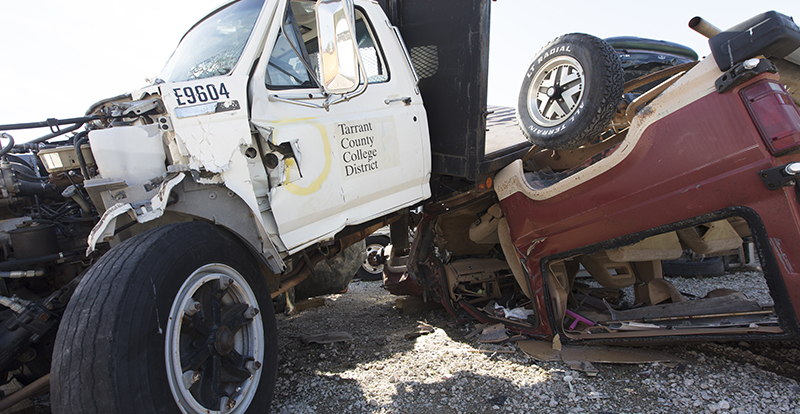 Perhaps TCC’s best kept recycling secret is how Tankersley’s team manages the College’s
vehicle fleet. After a vehicle has logged between 60,000 and 100,000 miles of service,
if it still meets safely standards when pulled from street service, it may be reassigned
to a specific campus for limited service, driven shorter distances and often at slower
speeds. After the odometer rolls past 100,000 miles, a vehicle that can still be driven
may be transferred to more abbreviated service, transporting groundkeepers across
bumpy terrain as they tend to campus landscapes.
Perhaps TCC’s best kept recycling secret is how Tankersley’s team manages the College’s
vehicle fleet. After a vehicle has logged between 60,000 and 100,000 miles of service,
if it still meets safely standards when pulled from street service, it may be reassigned
to a specific campus for limited service, driven shorter distances and often at slower
speeds. After the odometer rolls past 100,000 miles, a vehicle that can still be driven
may be transferred to more abbreviated service, transporting groundkeepers across
bumpy terrain as they tend to campus landscapes.
Finally, when the vehicle can no longer be safely driven, it graduates from operations to the College’s academic arena. Vehicles lay in waiting until they are pulled into their last TCC service as props in fire service training scenarios (pictured left), providing realistic experiences for the first responders who come to TCC from across the state and beyond for state-of-the-art classes.
As TCC terminates ties with the once shiny, new vehicles, the College gains one final benefit when revenue is added to the College’s coffers from what now has been reduced to scrap metal.
Campus, Student Initiatives Focus on the Future
While the College continues reducing its overall negative impact on the environment, several campuses are contributing to the sustainability in each of their communities.
Of the more than 800 acres encompassing TCC properties, each campus has designated a fraction of its land for sustainability initiatives that connect students to nature through outdoor classrooms.
Northeast Campus
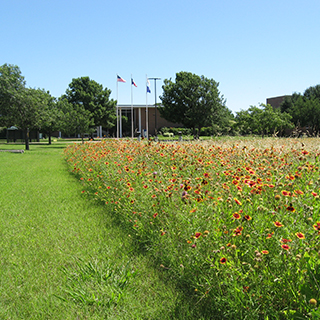 The Prairie Restoration Project at Northeast Campus began six years ago as a joint
effort between the biology and geology departments. “We have attempted to make it
as experiential as possible, working with students throughout the process; including
clearing, weeding, seeding and cleanup,” said geology instructor David Sallee, one
of the original faculty members involved.
The Prairie Restoration Project at Northeast Campus began six years ago as a joint
effort between the biology and geology departments. “We have attempted to make it
as experiential as possible, working with students throughout the process; including
clearing, weeding, seeding and cleanup,” said geology instructor David Sallee, one
of the original faculty members involved.
Both Sallee and fellow faculty member Marius Pfeiffer, a biology professor, have been interested and involved in the environment so long, they do not remember when it did not play a role in their lives.
“I have been interested in everything outdoors and the environment since I was a kid,” said Sallee, who tends a vegetable garden with the Northeast Campus Children’s Center and on his own. He also maintains a compost site on campus. Pfeiffer recalls his journey in biology, beginning in the third grade when he read all of Hugh Lofting’s books, catalyzing his love of reading, although he “cannot recall a period of his life when he was not fascinated with the natural world and particularly with living things.”
Northwest Campus
The Marine Creek Nature Discovery Center supports conservation on Northwest Campus and focuses on service learning and restoration, said Biology Professor Greta Bowling.
In a time where natural areas are fewer and farther between due to urban sprawl, educating youth and the community about the benefits of these essential ecosystems is of utmost importance.
Greta Bowling
“Colleges and universities across the nation have heard the call to action and have seen the benefits outdoor classrooms have on both promoting land stewardship as well as student success and retention,” Bowling said.
 Bowling said because outdoor classrooms are not limited to the sciences, she is working
with her colleagues in both the art and English departments to develop service learning
projects that encourage students to be “mindful of the world around us, and our impact
on that world.” She said studies have shown that the benefits of experiential learning
include “increasing knowledge retention, nurturing creativity, increasing collaboration
skills, developing self-confidence and self-knowledge and reinforcing the importance
of a relationship with the outdoors.”
Bowling said because outdoor classrooms are not limited to the sciences, she is working
with her colleagues in both the art and English departments to develop service learning
projects that encourage students to be “mindful of the world around us, and our impact
on that world.” She said studies have shown that the benefits of experiential learning
include “increasing knowledge retention, nurturing creativity, increasing collaboration
skills, developing self-confidence and self-knowledge and reinforcing the importance
of a relationship with the outdoors.”
A work in progress, plans this spring include seeding the prairie area with a mix of native grasses or flowers. Other proposed work includes developing a landscape design for that area that features walkways, benches, a monarch waystation and raised beds with appropriate signature. “Far in the future, we hope to develop a classroom setting that teaches sustainability through rainwater filtration systems and alternative energy technology,” Bowling said. “This would be a multi-discipline, multi-use facility with some climate control and bathrooms.”
South Campus
Last year, a delegation from South Campus was recognized by former First Lady Laura Bush at a Texan by Nature Celebration for the work started nearly two years ago to help the monarch butterfly and other pollinators. “Tarrant County College campuses are planting natives and making monarch way stations for monarchs as they migrate through,” Bush said. “The choices we make now will shape the world for the next generation.” Campus leadership joined the National Wildlife Federation’s Mayors’ Monarch Pledge committing to take nine specific actions. At South Campus, these actions include partnering with local gardeners, converting an area on campus to a monarch habitat, planting native milkweed and nectar plants and adopting safe pesticide practices.
The monarch population has been declining by about 90 percent in recent years from numbering some 1 billion in 1996, according to reports at the time the pledge was signed. The decline has been attributed to numerous threats, particularly loss of habitat due to agricultural practices, development and cropland conversion. Degradation of wintering habitat in Mexico and California has also had a negative impact on the species.
Monarchs are thought to have visited South Campus at least for the 50 years since the inception of the campus. The area has about 15 acres of wildlife preservation, not including the track area.
“A unified effort modeling conservation with the addition of milkweed while educating our community – including sister area universities and perhaps other regions along the I-35 corridor – could be the tipping point in the reversal of the decline of many of our pollinators in this region,” said Floreen Henry, assistant professor of French/language arts.
Southeast Campus
The latest sustainability initiative at Southeast Campus began last summer with the installation of the aquaponics system, a system that grows plants in water and without soil. Nutrients for the plants are provided by the waste produced by fish farmed in the system, which in turn purifies the water.
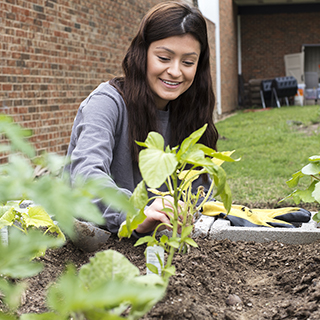 Assistant history professor Bradley Borougerdi, who has “always been interested in
how things grow,” brought the concept to the campus and oversaw its construction that
includes a cylinder tank that holds up to 350 gallons of water. Once the system matures,
multiple disciplines will work together to develop curriculum that will teach students
about the sustainability initiative. A long-term goal is to build a greenhouse over
the aquaponics pool, so that it can operate year-round.
Assistant history professor Bradley Borougerdi, who has “always been interested in
how things grow,” brought the concept to the campus and oversaw its construction that
includes a cylinder tank that holds up to 350 gallons of water. Once the system matures,
multiple disciplines will work together to develop curriculum that will teach students
about the sustainability initiative. A long-term goal is to build a greenhouse over
the aquaponics pool, so that it can operate year-round.
Nationally recognized as an official Tree Campus USA again in 2017, Southeast Campus has consistently been awarded the designation since it first earned the distinction in 2009. Five core standards to be named include the establishment of a tree advisory committee, evidence of a campus tree-care plan, dedicated annual expenditures for its campus tree program, an Arbor Day observance and the sponsorship of student service-learning projects.
“I am proud of the nine consistent years that the Southeast Campus has been designated a Tree Campus USA,” said Southeast Campus President Bill Coppola. “This reflects the hard work of a committee made up of administrators, faculty, staff and students who both recognize and encourage the entire campus to understand the benefits of trees and how they make for a better community for learning.”
Other campus sustainability initiatives include campus gardens, a Monarch Way Station and harvesting honey from the campus’ bee hives.
Trinity River Campus
Plans are underway for the campus to create TCC’s first micro-park as a place where students, faculty and community can step out to the Trinity Plaza and enjoy the art, activities, food and music for events.
The micro-park will be a collaborative effort, creating an art gallery without walls for student and community art, student and community event programming by Student Activities and TCC’s community partners. The space will include a staging area for live music, seating in the shade, lawn games, an outdoor kitchen and a butterfly garden of natural pollinators. The space will be designed help students, staff and faculty to realize Trinity River’s seventh Hallmark of Wellness as it serves as a gateway to the trails leading to the Trinity River. It could also be a meeting place for outdoor fitness classes as new outdoor learning spaces are created.
Student Activities also hosts an annual campus day of service that helps various agencies in Tarrant County to unite efforts to maintain the Trinity River and student organizations participate in Earth Day events, designed to unite people of many different cultures for the single purpose of caring for the earth.
Campuses Unify Efforts
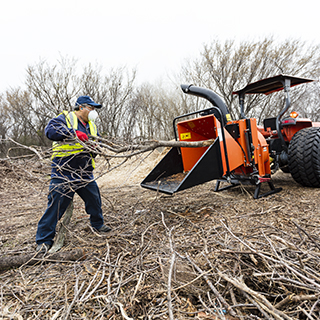 Recently, a group of faculty, staff and administrators across the College came together
to form the TCC Conservation Coalition. The goal of this committee is to combine the
efforts of all campuses to support a vision of experiential learning, as well as to
foster a culture of land stewardship among students, faculty and the community.
Recently, a group of faculty, staff and administrators across the College came together
to form the TCC Conservation Coalition. The goal of this committee is to combine the
efforts of all campuses to support a vision of experiential learning, as well as to
foster a culture of land stewardship among students, faculty and the community.
This new committee believes that by joining forces, TCC will become a leader among colleges hoping to develop outdoor classrooms and restore natural habitats, as well as increase the likelihood that curriculum and programs created under this committee will be more easily sustained across all college campuses.
One key initiative falling under TCC Conservation Coalition is their work with local farmers’ markets and recycling programs to educate the public and to form academic pathways from TCC to careers in sustainable land management. Future goals across the campuses include development of curriculum for outdoor classrooms, forming partnerships between the college and local school districts and improving community involvement through outdoor programming.
Future Important to Students
TCC’s commitment to sustainability is impacting students on its various campuses.
“Buildings offering an interactive experience (such as CEET at South Campus) can help millennials learn to address real-world situations while also preparing them for the challenges of tomorrow,” said McRee of Freese and Nichols. “But there is another benefit: These types of facilities and programs encourage students who may still be seeking a future trade.”
Not only are facilities impacting career choices, but participating in campus sustainability initiatives caused Southeast Campus student Somiari Tobin to select a minor. “Finding out about sustainability helped me realize how much of a passion I have for it,” said Tobin, currently the only student serving on the Southeast campus sustainability committee.
“I would someday love to introduce some of the things I’ve learned in communities around the country,” Tobin said. “I grew up and have lived in impoverished areas at different parts of my life. I know the interest would be there if kids who grew up in places like I did were exposed to things relating to sustainability.”
We are constantly surrounded by people who could be innovators in clean energy, sustainably and reliably sourced food…who simply don’t know about the field.
Somiari Tobin
On Northwest Campus, Marisa Wetzel was impressed by the educational experience she received from the Marine Creek Nature Discovery Center. “Outdoor classrooms are a great way for students to get hands on learning! I personally learn better when I get to have hands-on training,” Wetzel said. “Not only will they be learning but they will be having some impact in the school’s atmosphere, which is a great way to become part of TCC as a community. TCC is always trying to better the community. This project is just another way that they are able to do so.”
TCC students also have an opportunity to create sustainability initiatives by participating in various student organizations on their campuses including Environmental Science & Engineering Club, Horticulture 101 and Student Earth Advocates.
South Campus student Isaiah Thomas founded the Nutrition and Environmental Club in fall 2017. The group is organizing a survey to determine how to reduce paper waste on South Campus. Their goal is to begin their initial polling in April and continue gathering data in fall 2018, when the organization plans to make recommendations.
“As a new organization, our biggest concern is leaving a lasting impact. In whatever we do, we want our message to resonate,” Thomas said. “At least people can think twice before they litter or observe wildlife and nature from a different perspective.”
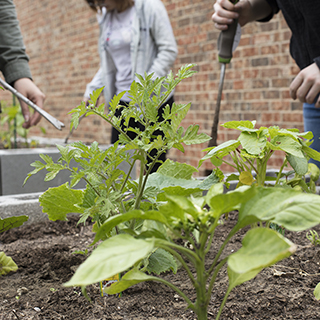


![//parameter[@name='author']](/magazine/assets/images/authors/rita-parson.jpg)